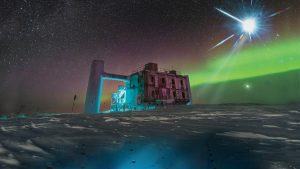Kathryn Jepsen in Symmetry:
 On September 22, 2017, a tiny but energetic particle pierced Earth’s atmosphere and smashed into the planet near the Amundsen-Scott South Pole Station in Antarctica. The collision set loose a second particle, which lit a blue streak through the clear ice.
On September 22, 2017, a tiny but energetic particle pierced Earth’s atmosphere and smashed into the planet near the Amundsen-Scott South Pole Station in Antarctica. The collision set loose a second particle, which lit a blue streak through the clear ice.
Luckily for science, the first particle was a neutrino, and the strike occurred within the cubic kilometer that makes up the IceCube neutrino experiment. Its detectors recorded the hit and sent out a public alert. The trail of light left behind by the second particle, a muon, pointed back to an intriguing object 4 billion light-years away: a violent, particle-flinging galaxy called a blazar, powered by a supermassive black hole.
This is the first time scientists have found evidence of the birthplace of an ultra-high-energy cosmic neutrino. And it is the second big result—after an August 2017 blockbuster from the Laser Interferometer Gravitational-Wave Observatory and a band of additional experiments—in what scientists are calling a new era of multi-messenger astronomy.
In multi-messenger astronomy, experiments work together to study two or more different kinds of signals, such as gamma rays and neutrinos, from a single highly energetic event in a galaxy far away, says Regina Caputo, analysis coordinator for the Fermi Gamma-ray Space Telescope’s Large Area Telescope instrument.
More here.
